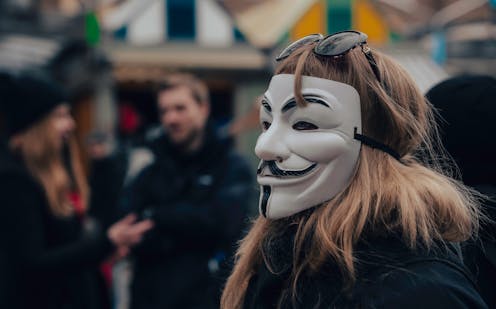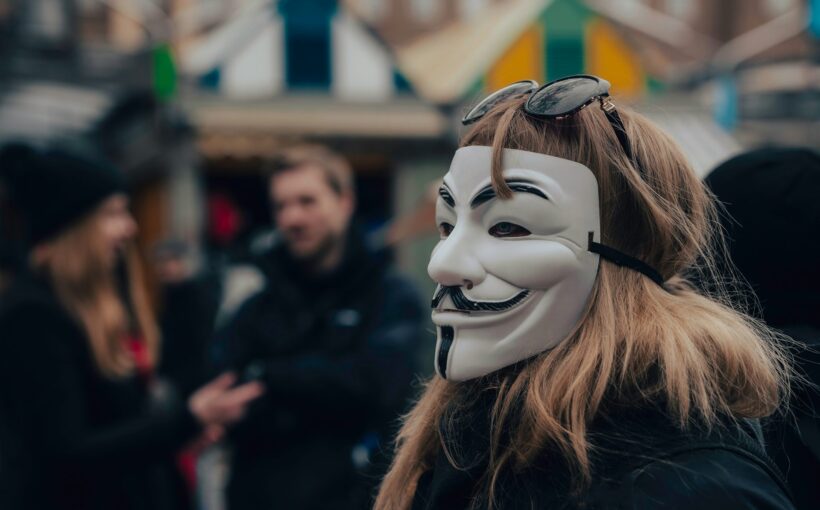
It’s a dangerous time for protest rights in the UK. The government has introduced a bill that would make it a criminal offence to conceal your identity at a protest.
The crime and policing bill establishes an offence if a person conceals their identity within a specifically designated area. That is, an area where the police believe that a protest is taking place, or is likely to take place, and that involves, or might involve, the “commission of offences” (people breaking the law).
These powers are preemptive and vague – how is the “likelihood” of a protest or offences determined? What specific “offences” does the bill refer to? What safeguards exist? Ultimately, the bill does not appear to place any real limits on the degree of discretion extended to the police.
The passage of this bill would have significant implications for the right to anonymity in public places. It is unparalleled among liberal democratic states, bringing UK practice into line with Russia, Hungary and China.
Under existing public order law, police already have the power to direct people to remove face coverings. The police justify these new powers on the basis that “individuals may follow the initial direction of the police officer to remove their face covering, but … move … and redeploy the face covering shortly afterwards.”
The bill continues the previous government’s attempts to erode the right to protest. It’s clear that the motivation for these laws is not concern for public safety, but a desire to significantly extend surveillance powers.
Facial recognition
Why is a ban on face coverings being introduced now? No significant new challenges to the policing of protest have emerged in recent decades. The difference now, however, is that facial recognition has recently become a viable policing technology.
As our forthcoming book details, facial recognition technology has rapidly transformed police surveillance capabilities, with profound effects on human rights, the formation of suspicion and on interactions between police and citizens.
Retrospective facial recognition (the use of facial recognition on recorded materials) is now used by every police force in the UK, and has been, in some cases, for more than a decade. This expansion occurred under the radar and without public debate. Its extent was only revealed through investigative journalism.
Live facial recognition, which involves real-time identity checks, is also expanding. South Wales Police recently deployed this technology across Cardiff’s pedestrian areas. And London’s Metropolitan Police are planning to install the first permanent live facial recognition cameras in the capital.
Being identified by police was once only a possibility, now it is a near certainty. The only rules currently governing the police’s use of facial recognition are developed by police forces themselves.

In recognition of the dangers posed by such surveillance, we were recently involved in developing, with the UN, a model protocol for law enforcement. It sets out practical guidance that all states should follow when policing protest, making clear that efforts to preserve one’s anonymity should not be treated as suspicious.
It explicitly prohibits the use of remote biometric technology, like facial recognition or retina scanning, to identify protesters during peaceful demonstrations – something we argue is inconsistent with police’s obligation to facilitate peaceful protest. This protocol was unanimously adopted by the 47 member states of the UN Human Rights Council.
Why the right to anonymity matters
The right to privacy, freedom of expression and freedom of assembly are central to the health of a democratic society. This includes the ability to participate anonymously in protests.
But these rights are not absolute. This means that they can be limited – including in the interests of public safety or the prevention of crime and disorder – if doing so can be considered “necessary in a democratic society”. Given the importance of protest to democratic life, the threshold is high.
The purpose of protest is to disrupt. The fights for women’s right to vote, trade union recognition and racial equality are all examples where a degree of disruption and disorder has been an intrinsic part of political change. Human rights law requires that public authorities show a certain degree of tolerance in this regard.
To this end, human rights case law recognises that, no matter how shocking or “unacceptable”, any restrictions on freedom of expression and of assembly – other than in cases of incitement to violence, hate speech, or the rejection of democratic principles – risk undermining democracy itself.
There is strong research evidence that surveillance of protesters cultivates chilling effects, whereby individuals change their otherwise normal behaviour due to the fear of surveillance. As we explain, this generates compound human rights harms that may fundamentally undermine the ability of citizens to challenge the status quo.
With this proposed law, the UK is moving out of line with other democratic states and closer into step with Russia and China. Without changes, this bill risks transforming protests into surveillance opportunities.
![]()
Daragh Murray receives funding from UKRI Future Leaders Fellowship, Grant Number: MR/T042133/2.
Pete Fussey does not work for, consult, own shares in or receive funding from any company or organisation that would benefit from this article, and has disclosed no relevant affiliations beyond their academic appointment.



